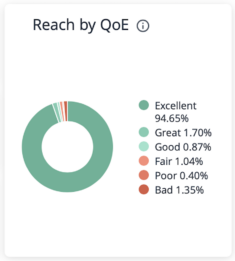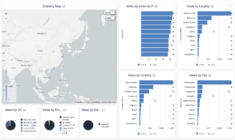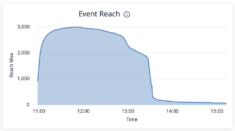The Rise of Zero Trust Networks
The Rise of Zero Trust Networks
In the past two years, we have witnessed a rapid evolution in cybersecurity and a rise in Zero Trust security as a top priority for organizations across the globe. With the shift to remote and hybrid work models, businesses must adapt to support employees working in locations beyond the perimeter of the corporate network. Increased prevalence of cloud-based services, the internet of things (IoT), and the growing sophistication of cyberattacks has caused business leaders to adopt more robust security protocols.
In response to these changes, the adoption of Zero Trust security models has skyrocketed across diverse markets and industries. In their report titled, “The State of Zero Trust Security 2021 ,” identity management firm Okta found that Zero Trust has increased in priority for 78% of businesses. Microsoft’s 2021 “Zero Trust Adoption Report ” echoed these sentiments, stating, “Security decision-makers (SDMs) say developing a Zero Trust strategy is their #1 security priority, with 96% saying it’s critical to their organization’s success.”
As more businesses switch to Zero Trust security models, software solutions they rely on must perform and comply with these new security practices. Kollective’s Edge Accelerator was built with Zero Trust security in mind, allowing businesses to scale content delivery in evolving network environments.
This article will review the basics of Zero Trust, the factors leading to the increase in Zero Trust adoption, where adoption is occurring, and how Kollective enables businesses with Zero Trust networks.
What is Zero Trust?
Zero Trust is a security model based on the principle: “never trust, always verify.” In Zero Trust networks, no device is trusted by default. Users must be authenticated, authorized and continually validated before being granted access to applications and data, whether they are inside or outside the organization’s network.
Zero Trust networks redefine the traditional understanding of the network edge. In Zero Trust frameworks, networks can be local, in the cloud, or a combination of the two – supporting workers in any location. With pushes towards digital transformation, Zero Trust allows businesses to ad dress the challenges of the modern office, including securing remote employees and hybrid cloud environments.
Hybrid Work is Driving Zero Trust Adoption
Zero Trust models have been a part of the enterprise for over a decade. Google implemented Zero Trust architecture into their security model as far back as 2009. The growth of Zero Trust strategies in the 2010s was slow, but has accelerated over the past three years. The increase was fueled by the rise of mobile computing, the internet of things (IoT), and cloud-based services, and the pandemic only amplified these problems. Existing challenges and the subsequent shift to remote and hybrid workplaces have driven Zero Trust adoption to record highs as leadership seeks better ways to safeguard systems and data as employees access them off-site and through personal devices.
Business leaders confirmed that the move to hybrid work models accelerated their Zero Trust timelines. In a poll of over 600 global security leaders, Okta found that the challenges of hybrid work caused businesses to become “more security conscious” and forced them to prioritize Zero Trust strategies. As a result, most companies (90%) are actively pursuing Zero Trust initiatives, up from 41% in 2020. While many companies are still determining how to integrate Zero Trust frameworks, Microsoft found that implementation is well underway – “76% of organizations have at least started implementing a Zero Trust strategy with 35% claiming to be fully implemented.”
Zero Trust Adoption Varies by Industry
While Zero Trust initiatives have increased across all industries, Okta discovered that adoption varies among key verticals. Highly regulated industries, like financial services, lead other verticals in their use of Zero Trust, with 94% reporting they already have Zero Trust frameworks in place or “have aggressive goals to get there.” Other industries with notable pushes towards Zero Trust include healthcare and software. Almost one-third (30%) of healthcare organizations stated that Zero Trust is now a top priority compared to 17% globally. While software companies like Microsoft and Google implemented Zero Trust models, only 9% of software organizations have a Zero Trust initiative currently in place. However, the industry is poised for change as nearly 4 in 5 plan to adopt initiatives by the end of next year.
EMEA Experiences the Largest Increase in Zero Trust Initiatives
In Okta’s report, they found that at least 87% of APAC, EMEA, and North American organizations have defined Zero Trust initiatives in place or plan to start them in the next 12-18 months. While all regions saw substantial increases in adoption since 2020, the most significant jump occurred in EMEA where Zero Trust initiatives grew by a factor of five.
Increase in Zero Trust Initiatives by Region
- APAC: 50% (2020) to 91% (2021)
- EMEA: 18% (2020) to 90% (2021)
- North America: 60% (2020) to 87% (2021)
Kollective Supports Zero Trust Networks
Secure by design. Creating an effective security design requires a comprehensive security policy woven into every layer of a solution, addressing present threats and future concerns. That is how Kollective’s Edge Accelerator was architected – with security in mind from conception to release, ensuring the highest degree of protection for your data.
Zero Trust with Kollective. As more businesses adopt Zero Trust frameworks, solutions must adhere to their security standards. Kollective’s Edge Accelerator provides best-in-class content delivery mechanisms and offers advanced security controls to support networks operating in Zero Trust environments. Learn more about Kollective’s security .
Performance without Security Risks. In Microsoft’s study, overall security and the end-user experience were the primary motivators for organizations adopting Zero Trust frameworks. These priorities are directly in line with Kollective’s goals – to flawlessly deliver content to any user in any location securely. Kollective’s Edge Accelerator handles the most diverse network needs, from delivering video to China to supporting hybrid workplaces with complex network environments. Kollective provides businesses with flexibility and the confidence that their network will always work.
Talk to an expert today to see how Kollective’s ECDN solutions excel in Zero Trust network environments.
The post The Rise of Zero Trust Networks appeared first on Kollective Technology .





